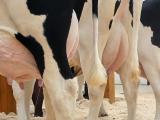Scientists from the Centers for Disease Control and Prevention (CDC) and their collaborators in Texas today shared new details about an investigation into a recently reported H5N1 avian flu infection in a dairy worker—likely the first known transmission of the virus between mammals and a human.
The team detailed their clinical and genetic sequencing findings today in a letter to the New England Journal of Medicine. The man's infection, which was mild and consisted of conjunctivitis, was first reported on April 1, and the CDC shared its initial sequencing findings the following day.
Follow-up clinical probe stymied by lack of access
The man's right-eye conjunctivitis began in late March. He didn't have contact with sick or dead birds or other animals but did have direct contact with healthy dairy cows, as well as ones that had illness signs that were similar to those at nearby facilities where H5N1 was confirmed. He said he wore gloves while working, but not respiratory or eye protection.
Researchers said the man's eyes could have become infected by touching them with virus-contaminated hands, or from exposure to respiratory droplets or aerosols from sick cows or activities in the dairy setting.
Health workers collected nasopharyngeal and conjunctival swabs, which were positive for H5N1 via PCR testing. There was enough RNA in the conjunctival sample for full genome sequencing, and scientists were able to grow the virus from both specimens.
The patient also developed redness in his left eye. He and his household contacts received oseltamivir (Tamiflu), and over the following days, the man recovered, and no symptoms were reported in his contacts.
We were also unable to collect acute or convalescent sera to assess seroconversion in the dairy farm worker or household contacts.
In the supplementary appendix, researchers said they weren't able to do a follow-up investigation on the sick worker or other exposures among workers at the farm. They also noted that they weren't able to collect follow-up specimens from the patient to track viral loads or shedding duration. "We were also unable to collect acute or convalescent sera to assess seroconversion in the dairy farm worker or household contacts," the group wrote.
A spokesperson for the Texas Department of State Health Services told CBS News that the Texas dairy worker came to a Texas field office for testing and did not disclose the name of his workplace.
Data gaps but strong evidence of cow-to-human spread
Initial sequencing found that the virus belonged to the same B3.13 genotype circulating in dairy cows, and virus isolation from both specimens yielded identical viruses. As reported earlier by the CDC, the virus in the man's specimen had a change, PB2 E67K, that has a known link to virus adaptation to mammalian hosts.
In the supplementary appendix, the group said when they compared the sequence from the patient with the available cattle sequences, they found that the human sequence lies just outside the larger cluster of cattle sequences from Texas, though it is closer to cattle than B3.13 genotype viruses from wild birds or wild mammals.
"Sequence data from the farm where the infected dairy farm worker was exposed to presumably infected was not available," they wrote, noting that the sequencing picture so far has gaps and suggests the virus may have been circulating undetected for some time.
They said it's possible that the patient was infected with an earlier slightly different virus or that there was more than one independent spillover of the B3.13 genotype from wild birds to cattle.
Taken together, though, they wrote the genetic and epidemiologic evidence provide strong evidence of transmission from a sick cow to a human.




















